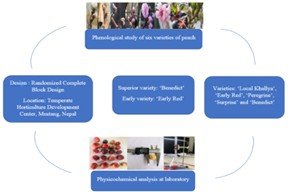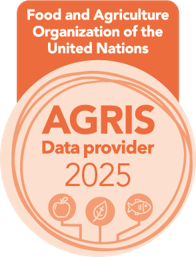Assessment of phenological and physicochemical characteristics of peach (Prunus persica L.) varieties in Mustang, Nepal
Abstract
This research was conducted at the Temperate Horticulture Development Center (THDC), Mustang, Nepal, to study flowering phenology and evaluate the physicochemical characteristics of five peach varieties (Surprise, Benedict, Peregrine, Local Khallya and Early Red) from February to September 2023. This research was conducted on a randomized complete block design with four replications and five treatments (fruit trees of a particular variety were replicated four times). The flowering phenology of varieties was studied by dividing the developmental stages of a flower into eight different stages: first swelling, calyx green, calyx red, first pink, first bloom, full bloom, petal fall and fruit set. The completion of each phenological stage was marked from a reference date. Physicochemical analysis of fruits was performed following UPOV guidelines of peach. Physical characteristics were encompassed in individual fruit weight, fruit length, fruit volume, fruit size (length and width), stone weight, stone size (length and width) and mesocarp thickness and in chemical characteristics, pH, total soluble solids (TSS), titratable acidity (TA) and TSS/TA ratio were included. The study of flowering phenology revealed that Early Red was found to be the earliest (60.50 DARD) to reach the fruit-set stage. The highest and lowest fruit weights were measured in Benedict (153.85 g) and Early Red (46.5 g), respectively. Finally, chemical analysis revealed that TSS/TA was found to be maximum in Benedict (12.38) and minimum in Early Red (6.03). It can be concluded that Early Red was the earliest maturing variety among the varieties. Also, Benedict was found to be the superior in terms of sweetness and size.
Keywords:
Chemical characteristics, Peach (Prunus spp.), Phenological stages, Total soluble solids, VarietiesDownloads
References
Alhaj Alali, F., Askari Sarcheshmeh, M., & Bababalar, M. (2023). Evaluating the effects of citric acid application on reducing decay, maintaining edibility and shelf life of peach fruits in cold storage. International Journal of Horticultural Science and Technology, 10(2), 149-160. https://doi.org/10.22059/ijhst.2022.328720.490
Bhardwaj, S., & Chand, H. (2021). Phenological variations and Growing degree days requirement of commercially important cultivars of apple Malus domestica in contrasting climatic regimes of Himachal Pradesh, India. Ludhiana: Punjab Agricultural University.
Cascales, A., Costell, E., & Romojaro, F. (2005). Effects of the degree of maturity on the chemical composition, physical characteristics and sensory attributes of peach (Prunus persica) cv. Caterin. Food science and Technology International, 11(5), 345-352. https://doi.org/10.1177/1082013205057943
Chapman, P., & Catlin, G. (1976). Growth stages in fruit trees-from dormant to fruit set. New York’s Food and Life Sciences Bulletin. 58(58), 1-12.
Cifuentes-Carvajal, A., Chaves-Córdoba, B., Vinson III, E., Coneva, E., Chavez, D., & Salazar-Gutiérrez, M. (2024). Predicting floral bud progression for three peach cultivars. agronomy, 14(2). https://doi.org/10.3390/agronomy14020240
Cirilli, M., Gattolin, S., Chiozzotto, R., Baccichet, I., Pascal, T., Quilot-Turion, B., & Bassi, D. (2021). The Di2/pet variant in the PETALOSA gene underlies a major heat requirement-related QTL for blooming date in peach [Prunus persica (L.) Batsch]. Plant and Cell Physiology, 62(2), 356-365. https://doi.org/10.1093/pcp/pcaa166
Cortés-Flores, J., Hernández-Esquivel, K., González-Rodríguez, A., & Hernández-Esquivel, K. (2017). Flowering phenology, growth forms, and pollination syndromes in tropical dry forest species: Influence of phylogeny and abiotic factors. American Journal of Botany, 104(1), 39-49. https://doi.org/10.3732/ajb.1600305
Dafaallah, A. (2019). 12 Duncan's multiple range test (DMRT). http://dx.doi.org/10.13140/RG.2.2.16262.93764
Ensle, K. (2015). Health benefits of peaches: A delicious summer fruit. Rutgers.
Frecon, J., Belding, R., & Lokaj, G. (2002). Evaluation of white-fleshed peach and nectarine varieties in New Jersey. Acta Horticulturae, 592, 467-478. http://dx.doi.org/10.17660/ActaHortic.2002.592.63
Ghrab, M., Zitouna, R., Masmoudi, M., & Mechlia, N. (2016). Phenology and yield efficiency of early, mid-, and late-maturing cultivars of peach in irrigated orchards under mediterranean climate. International Journal of Fruit Science, 16(3), 323-334. https://doi.org/10.1080/15538362.2015.1137532
Hack, H., Bleiholder, H., Buhr, L., Meier, U., Schnock-Fricke, U., Weber, E., & Witzenberger, A. (1992). Einheitliche codierung der phänologischen entwicklungsstadien mono-und dikotyler pflanzen–erweiterte BBCH-Skala, Allgemein. Nachrichtenblatt des deutschen Pflanzenschutzdienstes, 44(12), 265-270.
Hajilou, J., & Fakhimrezaei, S. (2011). Evaluation of fruit physicochemical properties in some peach cultivars. Research in Plant Biology, 1(5), 16-21.
Hans, M., Shah, M., & Bansal, R. (2020). Antioxidants in Fruits: Properties and Health Benefits. Singapore: Springer. https://doi.org/10.1007/978-981-15-7285-2_23
Hess, M., Barralis, G., Bleiholder, H., Buhr, L., Eggers, T., Hack, H., & Stauss, R. (1997). Use of the extended BBCH scale-general for the descriptions of the growth stages of mono; and dicotyledonous weed species. Weed Research, 37(6), 433-441.
Huynh, T. T., TonThat, L., & Dao, S. V. (2022). A vision-based method to estimate volume and mass of fruit/vegetable: Case study of sweet potato. International Journal of Food Properties, 25(1), 717-732. https://doi.org/10.1080/10942912.2022.2057528
Ikinsi, A., & Bolat, I. (2018). Yield and quality performance of some peach varieties grown in Sanliurfa conditions. African Journal of Agricultural Research, 13(2), 47-53. https://doi.org/10.5897/AJAR2017.12590
Kwon, J., Jun, J., Nam, E., Chung, K., Hong, S., Yoon, I., & Kwack, Y. (2015). Profiling diversity and comparison of Eastern and western cultivars of Prunus persica based on phenotypic traits. Euphytica, 206, 401-415. https://doi.org/10.1007/s10681-015-1494-0
Malla, G. (2008). Climate change and its impact on Nepalese Agriculture. The Journal of Agriculture and Environment, 9, 62-68.
Mazzoni, L., Medori, I., Balducci, F., Marcellini, M., Acciarri, P., Mezzetti, B., & Capocasa, F. (2022). Branch numbers and crop load combination effects on production and fruit quality of flat peach cultivars (Prunus persica (L.) Batsch) trained as catalonian vase. Plants, 11(3). https://doi.org/10.3390/plants11030308
Mehta, L., Hedge, A., Thomaas, A., & Virdi, M. (2019). Acidogenic potential of packaged fruit Juices and its effect on plaque and salivary pH. International Centre for Clinical Pediatric Dentistry, 12(4), 312-317. https://doi.org/10.5005/jp-journals-10005-1644
Milosevic, T., & Milosevic, M. (2012). Main physical and chemical traits of fresh fruits of promising plum hybrids (Prunus domestica L.) from Cacak (Western Serbia). Romanian Biotechnological Letters, 17(3), 7358-7365.
MoALD. (2022). Statistical information on Nepalese agriculture.
MoALD. (2023). Statistical information on Nepalese agriculture 2020/2021. Kathmandu, Nepal: Statistics and Analysis Section, Singha Durbar.
Mosie, T., Setu, H., & Seleshi, G. (2023). Physicochemical quality properties of peach (Prunus persica L.) varieties at Holetta, Ethiopia. Research Square, 1-16.
Mounzer, O., Conejero, W., Nicolos, E., Abrisqueta, I., Garcia-Orellana, Y., L.M., T., Ruiz- Sanchez, M. (2008). Growth pattern and phenological stages of early-maturing peach trees under a mediterranean climate. HortScience, 43(6), 1812-1818. https://doi.org/10.21273/HORTSCI.43.6.1813
Muharfiza, Al-Riza, D., Sen, N., Yasushi, K., Tetsuhito, S., Makoto, K., & Kondo, N. (2023). Effect of relative humidity and light exposure on fluorescence compound dynamics, soluble solid and acidity of Japanese citrus Iyokan during postharvest treatment. Advances in Food Science, Sustainable Agriculture and Agroindustrial Engineering, 6(2), 153-162.
Neupane, C., Pereira, M., Koirala, A., & Walsh, K. (2023). Fruit sizing in orchard: A review from caliper to machine vision with deep learning. Sensors, 23(8). https://doi.org/10.3390/s23083868
Nowicka, P., Wojdyło, A., & Laskowski, P. (2019). Principal component analysis (PCA) of physicochemical compounds’ content in different cultivars of peach fruits, including qualification and quantification of sugars and organic acids by HPLC. European Food Research and Technology, 245, 929-938. https://doi.org/10.1007/s00217-019-03233-z
Omayio, D., Abong, G., Okoth, M., Gachuiri, C., & Mwangombe, A. (2022). Physicochemical and processing qualities of Guava varieties in Kenya. International Journal of Fruit Science, 22(1), 329-345. https://doi.org/10.1080/15538362.2022.2039342
Paul, V., Singh, A., & Pandey, R. (2010). Determination of Titrable Acidity (TA). Post-harvest physiology of fruits and flowers. 44.
Radovic, A., Rakonjac, V., Vico, G., Djordjevic, B., Durovic, D., Bakic, I., & Nikolic, D. (2020). Phenological characteristics and yield potential of some late-ripening peach hybrids. Crop Breeding and Applied Biotechnology, 20(4). https://doi.org/10.1590/1984-70332020v20n4a58
Shahkoomahally, S., Chang, Y., Brecht, J., Chaparro, J., & Sarkhosh, A. (2020). Influence of rootstocks on fruit physical and chemical properties of peach cv. UFSun. Food Science & Nutrition, 9(1), 410-413. https://doi.org/10.1002/fsn3.2005
Sharma, P., Singh, M., Bhardwaj, S., & Bhatia, H. (2019). Valuation of phenological cycles and thermal time of apple crop growing at different altitudinal gradients in North Western Himalayas. The Pharma Innovation Journal, 8(6), 850-854.
Singh, O., Kumar, A., Rai, R., & Kohli, K. (2016). Quality evaluation of low chill peach cultivars for preparationof ready-to-serve ‘Nectar’ drink. Journal of Dairying, Foods & Home Sciences, 35(4), 327-330. https://doi.org/10.18805/ajdfr.v35i4.6634
Sun, S., & Frelich, L. (2011). Flowering phenology and height growth pattern are associated with maximum plant height, relative growth rate and stem tissue mass density in herbaceous grassland species. Journal of Ecology, 99(4), 991-1000. https://doi.org/10.1111/j.1365-2745.2011.01830.x
Szot, I., Goncharovsko, I., Klymenko, S., & Bulakh, P. (2022). Importance of old and local apple cultivars. Agrobiodiversity for Improving Nutrition, Health and Life Quality, 6(2), 156-170.
THDC. (2023). Annual Progess Report. Temperate Horticulture Development Center, Marpha, Mustang.
UPOV. (2021). Guidelines for the conduct of tests for distinctness, uniformity and stability. Retrieved from International Union for the Protection of New Varieties of Plants : https://www.upov.int/edocs/tgdocs/en/tg053.pdf
Wang, X., Zhang, B., Guo, S., Guo, L., Chen, X., He, X., & Yu, M. (2022). Effects of fruit load on photosynthetic characteristics of peach leaves and fruit quality. Scientia Horticulturae, 299. https://doi.org/10.1016/j.scienta.2022.110977
Yan, J., Cai, Z., Chen, Z., Zhang, B., Li, J., Xu, J., & Shen, Z. (2024). Relationship between chilling accumulation and heat requirement for flowering in peach varieties of different chilling requirements. Agronomy, 14(8). https://doi.org/10.3390/agronomy14081637
Zheng, B., Zhao, L., Jiang, X., Cherono, S., Liu, J., Ogutu, C., & Han, Y. (2021). Assessment of organic acid accumulation and its related genes in peach. Food Chemistry, 334. https://doi.org/10.1016/j.foodchem.2020.127567
Zohrabi, S., Seiiedlou, S., & Alipasandi, A. (2013). Study some physical and mechanical properties of three cultivars of peach in Maturation Stages. World of Scienes Journal, 4.

Published
How to Cite
Issue
Section
Copyright (c) 2024 Agriculture and Environmental Science Academy

This work is licensed under a Creative Commons Attribution-NonCommercial 4.0 International License.

